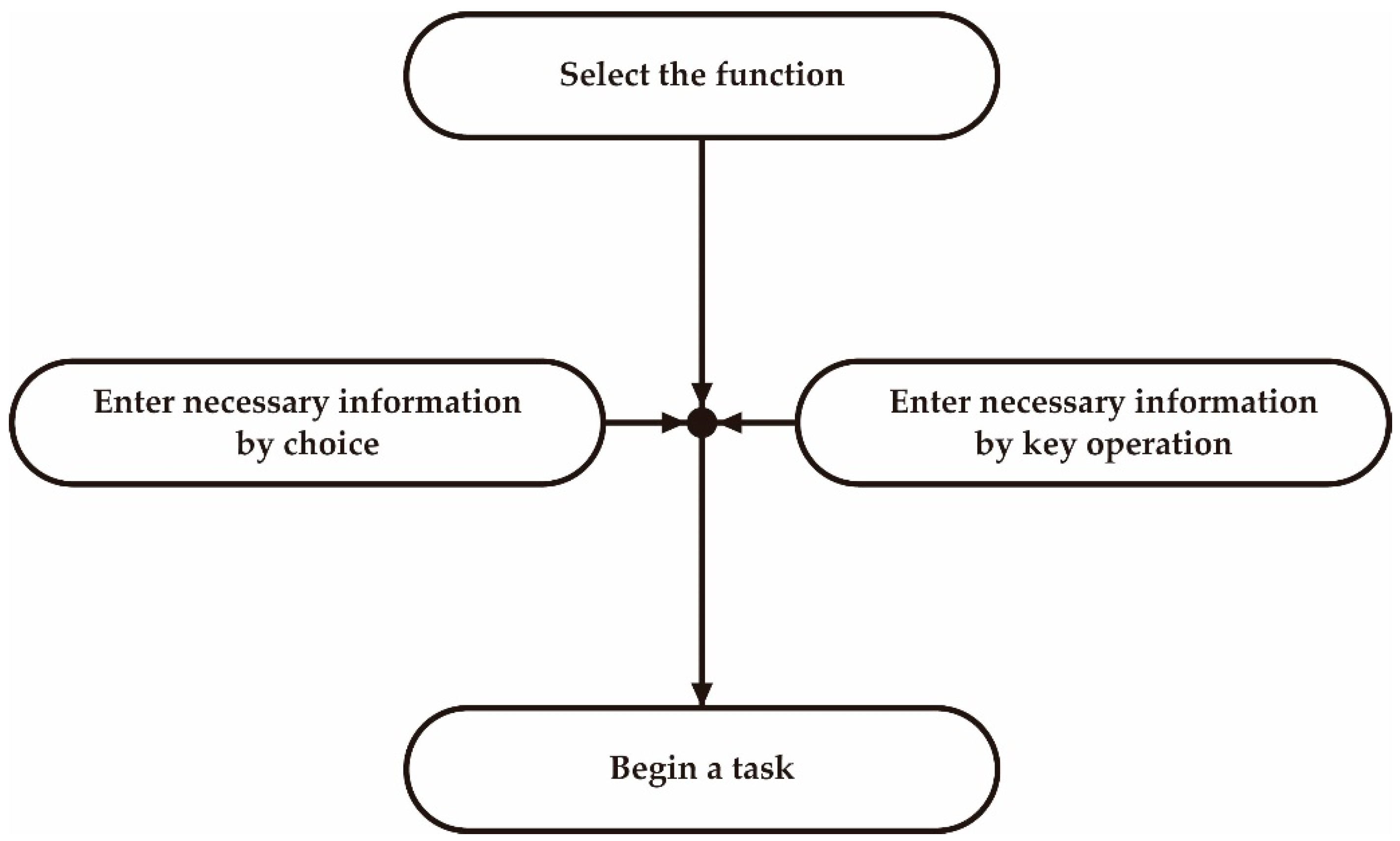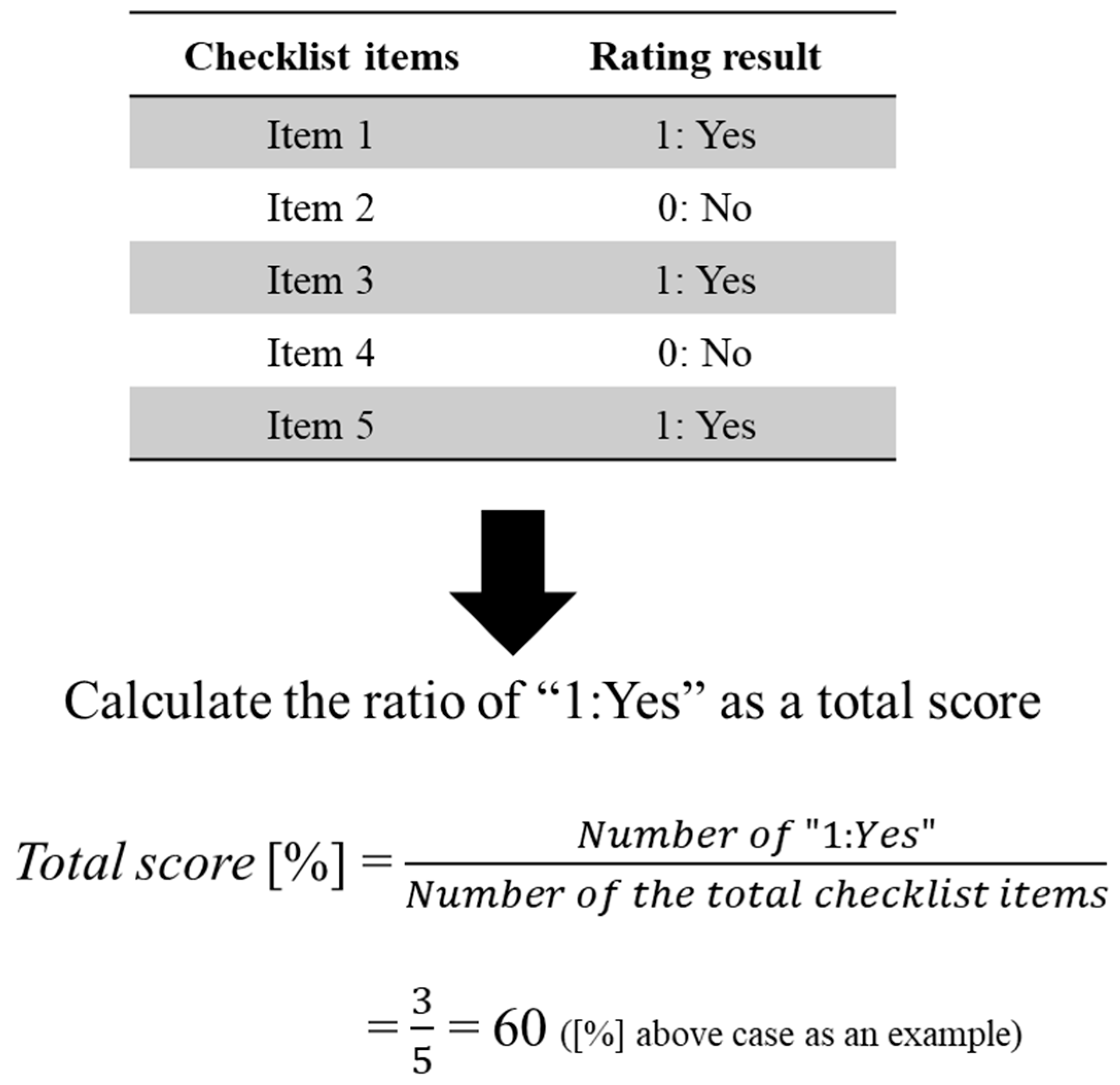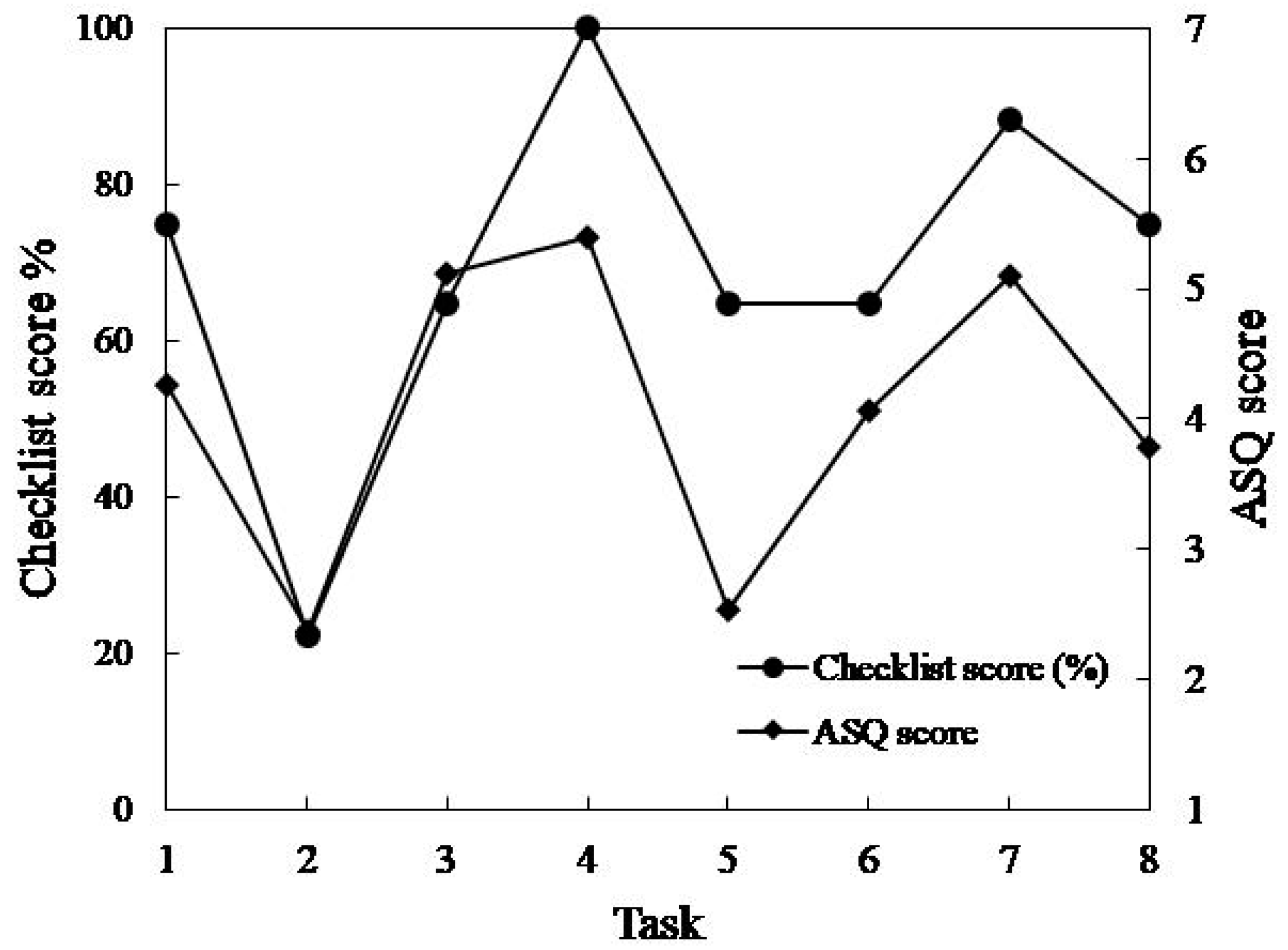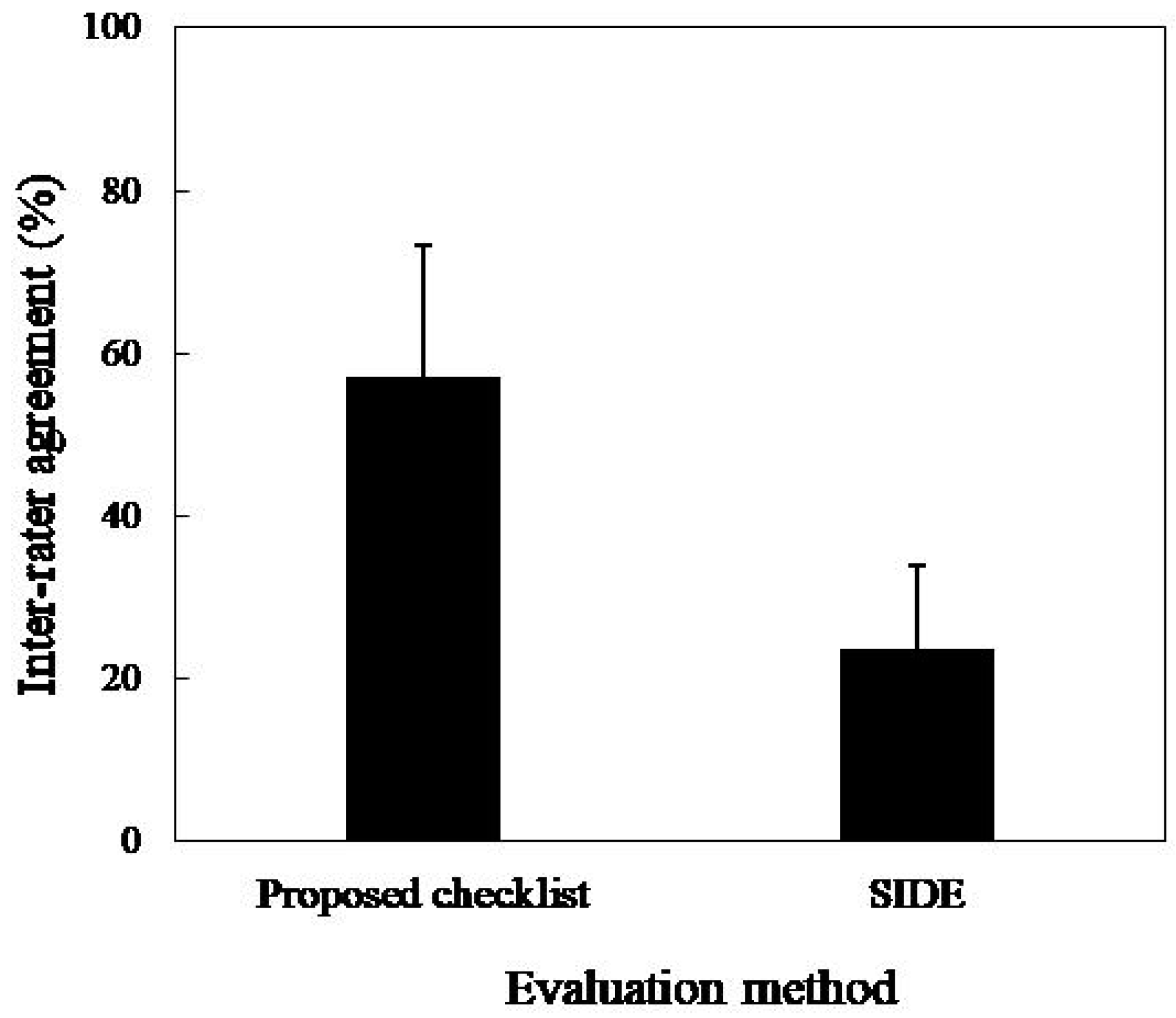Appendix A
The proposed checklists of all patterns are shown as follows.
The checklist in Pattern 1
Items examining the entirety of a task
- -
Are there any clues for supposing the following operation?
- -
Can users easily understand the vocabulary or the icons?
- -
Are there any friendly and smooth forms of feedback for the operation?
- -
Can users easily suppose the operation method?
- -
Can users understand immediately the relationship among UI parts?
- -
Are the layouts of operation panels or screens standardized?
- -
Is there consistency in the operation method?
Items examining each subtask in a task
(Select the function)
- -
Can users easily understand where the choices are?
- -
Is the operation panel or screen simple?
- -
Can users easily grasp the entirety of the selecting functions?
(Enter necessary information by choice)
- -
Can users easily understand where the choices are?
- -
Can users easily grasp an entirety of the choices?
(Enter necessary information by key operation)
- -
Can users operate UI with few and efficient operation procedures?
- -
Can users easily understand the operation portion?
- -
Can users easily grasp the entirety of the operation portion? Begin a task
- -
Can users easily understand the operation portion?
The checklist in Pattern 2
Items examining entirety of a task
- -
Are there any clues for supposing the following operation?
- -
Can users easily understand the vocabulary or the icons?
- -
Are there any friendly and smooth forms of feedback for the operation?
- -
Can users easily suppose the operation method?
- -
Can users understand immediately the relationship among UI parts?
Items examining each subtask in a task
(Select the function)
- -
Can users easily understand where the choices are?
- -
Is the operation panel or screen simple?
- -
Can users easily grasp the entirety of the selecting functions?
The checklist in Pattern 3
Items examining entirety of a task
- -
Are there any clues for supposing the following operation?
- -
Can users easily understand the vocabulary or the icons?
- -
Are there any friendly and smooth forms of feedback for the operation?
- -
Can users easily suppose the operation method?
- -
Can users understand immediately the relationship among UI parts?
- -
Are the layouts of operation panels or screens standardized?
- -
Is there consistency in the operation method?
- -
Can users easily understand the timing of task beginning?
Items examining each subtask in a task
(Select the function)
- -
Can users easily to understand where the choices are?
- -
Is the operation panel or screen simple?
- -
Can users easily grasp the entirety of the selecting functions?
(Enter necessary information by choice)
- -
Can users easily understand where the choices are?
- -
Can users easily grasp an entirety of the choices?
(Enter necessary information by key operation)
- -
Can users operate UI with few and efficient operation procedures?
- -
Can users easily understand the operation portion?
- -
Can users easily grasp the entirety of the operation portion?
The checklist in Pattern 4
Items examining entirety of a task
- -
Are there any clues for supposing the following operation?
- -
Can users easily understand the vocabulary or the icons?
- -
Are there any friendly and smooth forms of feedback for the operation?
- -
Can users easily suppose the operation method?
- -
Can users understand immediately the relationship among UI parts?
- -
Can users understand immediately the operation result?
- -
Can parameter adjustment be conducted in real time?
Items examining each subtask in a task
(Select the function)
- -
Can users easily understand where the choices are?
- -
Is the operation panel or screen simple?
The checklist in Pattern 5
Items examining entirety of a task
- -
Are there any clues for supposing the following operation?
- -
Can users easily understand the vocabulary or the icons?
- -
Are there any friendly and smooth forms of feedback for the operation?
- -
Can users easily suppose the operation method?
- -
Can users understand immediately the relationship among UI parts?
- -
Are the layouts of operation panels or screens standardized?
- -
Is there consistency in the operation method?
- -
Can users understand consistently the situation in users?
Items examining each subtask in a task
(Guide users’ operation outside the screen)
- -
Can users understand immediately the input method of media by appearances of the operation portion?
- -
Can users easily understand the timing of input or output of media?
- -
Can users understand immediately relationship between the input or output portion and the operation portion?
- -
Can users easily understand the input or output portion?
- -
Are there clear clues for setting the media?
- -
Can users operate the UI in a natural attitude?
- -
Can users easily understand messages conducive to input-output of the media?
(Enter information)
- -
Can users operate UI with few and efficient operation procedures?
- -
Can users easily understand where the operation portion?
- -
Can users easily grasp the entirety of the operation portion?
- -
Can users easily understand the choices are?
(Show the confirming message)
- -
Can users easily understand the confirming contents?
- -
Can users easily understand that non-invertible operation is begun?
- -
Can users easily understand the message display portion?
(Begin a task)
- -
Can users easily understand the operation portion?
The checklist in Pattern 6
Items examining entirety of a task
- -
Are there any clues for supposing the following operation?
- -
Can users easily understand the vocabulary or the icons?
- -
Are there any friendly and smooth forms of feedback for the operation?
- -
Can users easily suppose the operation method?
- -
Can users understand immediately the relationship among UI parts?
- -
Are the layouts of operation panels or screens standardized?
- -
Is there consistency in the operation method?
- -
Can users understand consistently the situation in users?
Items examining each subtask in a task
(Guide users’ operation outside the screen)
- -
Can users understand immediately the input or output method of media by appearances of the operation portion?
- -
Can users easily understand the timing of input or output of media?
- -
Can users understand immediately relationship between the input or output portion and the operation portion?
- -
Can users easily understand the input or output portion?
- -
Are there clear clues for setting the media?
- -
Can users operate the UI in a natural attitude?
- -
Can users easily understand messages conducive to input-output of the media?
(Begin a task)
- -
Can users easily understand the operation portion?
The checklist in Pattern 7
Items examining entirety of a task
- -
Are there any clues for supposing the following operation?
- -
Can users easily understand the vocabulary or the icons?
- -
Are there any friendly and smooth forms of feedback for the operation?
- -
Can users easily suppose the operation method?
- -
Can users understand immediately the relationship among UI parts?
- -
Are the layouts of operation panels or screens standardized?
- -
Is there consistency in the operation method?
- -
Can users understand consistently the situation in users?
Items examining each subtask in a task
(Select the function)
- -
Can users easily understand where the choices are?
- -
Is the operation panel or screen simple?
- -
Can users easily grasp the entirety of the selecting functions?
(Show the confirming message)
- -
Can users easily understand where the choices are?
- -
Is the operation panel or screen simple?
- -
Can users easily grasp the entirety of the selecting functions?
(Begin a task)
- -
Can users easily understand the operation portion?
(Guide users’ operation outside the screen)
- -
Can users understand immediately the output method of media by appearances of the operation portion?
- -
Can users easily understand the timing of output of media?
- -
Can users understand immediately relationship between the output portion and the operation portion?
- -
Can users easily understand where the output portion?
- -
Can users operate the UI in a natural attitude?
- -
Can users easily understand messages conducive to output of the media?
The checklist in Pattern 8
Items examining entirety of a task
- -
Are there any clues for supposing the following operation?
- -
Can users easily understand the vocabulary or the icons?
- -
Are there any friendly and smooth forms of feedback for the operation?
- -
Can users easily suppose the operation method?
- -
Can users understand immediately the relationship among UI parts?
- -
Are the layouts of operation panels or screens standardized?
- -
Is there consistency in the operation method?
- -
Can users understand consistently the situation in users?
Items examining each subtask in a task
(Select the function)
- -
Can users easily understand where the choices are?
- -
Is the operation panel or screen simple?
- -
Can users easily grasp the entirety of the selecting functions?
(Enter necessary information by choice)
- -
Can users easily understand where the choices are?
- -
Can users easily grasp an entirety of the choices?
(Enter necessary information by key operation)
- -
Can users operate UI with few and efficient operation procedures?
- -
Can users easily understand the operation portion?
- -
Can users easily grasp the entirety of the operation portion?
(Show the confirming message)
- -
Can users easily to understand where the choices are?
- -
Is the operation panel or screen simple?
- -
Can users easily grasp the entirety of the selecting functions?
(Begin a task)
- -
Can users easily understand the operation portion?
(Guide users’ operation outside the screen)
- -
Can users understand immediately the output method of media by appearances of the operation portion?
- -
Can users easily understand the timing of output of media?
- -
Can users understand immediately relationship between the output portion and the operation portion?
- -
Can users easily understand where the output portion?
- -
Can users operate the UI in a natural attitude?
- -
Can users easily understand messages conducive to output of the media?
The checklist in Pattern 9
Items examining entirety of a task
- -
Are there any clues for supposing the following operation?
- -
Can users easily understand the vocabulary or the icons?
- -
Are there any friendly and smooth forms of feedback for the operation?
- -
Can users easily suppose the operation method?
- -
Can users understand immediately the relationship among UI parts?
- -
Can users understand consistently the situation in users?
Items examining each subtask in a task
(Select the method)
- -
Can users easily understand where the choices are?
- -
Is the operation panel or screen simple?
- -
Can users easily grasp the entirety of the choices? Enter necessary information by choice
- -
Can users easily understand where the choices are?
- -
Can users easily grasp an entirety of the choices?
(Enter necessary information by key operation)
- -
Can users operate UI with few and efficient operation procedures?
- -
Can users easily understand the operation portion?
- -
Can users easily grasp the entirety of the operation portion?
(Show the list)
- -
Can users operate UI with few and efficient operation procedures?
- -
Can users easily grasp the entirety of the list display portion?
(Show the contents particularly)
- -
Are there any clues for supposing the following operation?
- -
Can users easily understand where the back button?
- -
Can users easily grasp the entirety of information?
The checklist in Pattern 10
Items examining entirety of a task
- -
Are there any clues for supposing the following operation?
- -
Can users easily understand the vocabulary or the icons?
- -
Are there any friendly and smooth forms of feedback for the operation?
- -
Can users understand immediately the relationship among UI parts?
- -
Can users understand consistently the situation in users?
- -
Is the operation panel or screen simple?
- -
Can users easily grasp the entirety of the choices?
Items examining each subtask in a task
(Show the list)
- -
Can users operate UI with few and efficient operation procedures?
- -
Can users easily grasp the entirety of the list display portion?
(Show the contents particularly)
- -
Are there any clues for supposing the following operation?
- -
Can users easily understand where the back button?
- -
Can users easily grasp the entirety of information?
The checklist in Pattern 11
Items examining entirety of a task
- -
Are there any clues for supposing the following operation?
- -
Can users easily understand the vocabulary or the icons?
- -
Are there any friendly and smooth forms of feedback for the operation?
- -
Can users easily suppose the operation method?
- -
Can users understand immediately the relationship among UI parts?
- -
Are the layouts of operation panels or screens standardized?
- -
Is there consistency in the operation method?
- -
Can users understand consistently the situation in users?
Items examining each subtask in a task
(Select the method)
- -
Can users easily understand where the choices are?
- -
Is the operation panel or screen simple?
- -
Can users easily grasp the entirety of the choices?
(Enter necessary information by choice)
- -
Can users easily understand where the choices are?
- -
Can users easily grasp an entirety of the choices?
(Show the contents particularly)
- -
Are there any clues for supposing the following operation?
- -
Can users easily understand the back button?
- -
Can users easily grasp the entirety of information?
The checklist in Pattern 12
Items examining entirety of a task
- -
Are there any clues for supposing the following operation?
- -
Can users easily understand the vocabulary or the icons?
- -
Are there any friendly and smooth forms of feedback for the operation?
- -
Can users easily suppose the operation method?
- -
Can users understand immediately the relationship among UI parts?
- -
Are the layouts of operation panels or screens standardized?
- -
Is there consistency in the operation method?
- -
Can users understand consistently the situation in users?
Items examining each subtask in a task
(Select the method)
- -
Can users easily understand where the choices are?
- -
Is the operation panel or screen simple?
- -
Can users easily grasp the entirety of the choices?
(Show the list)
- -
Can users operate UI with few and efficient operation procedures?
- -
Can users easily grasp the entirety of the list display portion?
(Select the method)
- -
Can users easily understand where the choices are?
- -
Is the operation panel or screen simple?
- -
Can users easily grasp the entirety of the choices?
(Enter necessary information by choice)
- -
Can users easily understand where the choices are?
- -
Can users easily grasp an entirety of the choices?
(Enter necessary information by key operation)
- -
Can users operate UI with few and efficient operation procedures?
- -
Can users easily understand the operation portion?
- -
Can users easily grasp the entirety of the operation portion?
(Show the contents particularly)
- -
Are there any clues for supposing the following operation?
- -
Can users easily understand the back button?
- -
Can users easily grasp the entirety of information?
The checklist in Pattern 13
Items examining entirety of a task
- -
Are there any clues for supposing the following operation?
- -
Can users easily understand the vocabulary or the icons?
- -
Are there any friendly and smooth forms of feedback for the operation?
- -
Can users easily suppose the operation method?
- -
Can users understand immediately the relationship among UI parts?
- -
Are the layouts of operation panels or screens standardized?
- -
Is there consistency in the operation method?
- -
Can users understand consistently the situation in users?
Items examining each subtask in a task
(Select the method)
- -
Can users easily understand where the choices are?
- -
Is the operation panel or screen simple?
- -
Can users easily grasp the entirety of the choices?
(Enter necessary information by choice)
- -
Can users easily understand where the choices are?
- -
Can users easily grasp an entirety of the choices?
(Enter necessary information by key operation)
- -
Can users operate UI with few and efficient operation procedures?
- -
Can users easily understand the operation portion?
- -
Can users easily grasp the entirety of the operation portion?
(Begin a task)
- -
Can users easily understand the operation portion?









